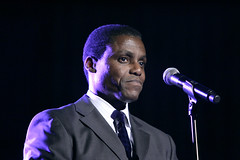Tuesday, September 22, 2009
Modern abolitionism
“New York Times” journalist Nicholas Kristof deems human trafficking “the big emerging human rights issue for the 21st century.” He also calls it “a convoluted euphemism.” What Kristof is intimating here is that human trafficking—that is, “the use of force, fraud, or coercion to exploit a person for profit,” according to the U.S. State Department’s 2009 Trafficking in Persons Report—cannot rightfully be called anything other than slavery. As the global slave trade reemerges, this time tied with arms dealing as the second largest organized crime pursuit in the world, a budding abolitionist movement is scrambling to muster enough strength to combat it.
When I first heard about the human trafficking problem, I was overwhelmed by the stories of young women sold into prostitution in brothels in Cambodia, families forced into debt bondage in India, and children abducted by rebel armies and forced to fight in the ongoing Ugandan civil war. It was only recently, thanks to Justin Dillon’s new documentary “Call + Response,” that I learned that the United States, and New York City, in particular, is also plagued by this evil that has once again reared its ugly head. Approximately 15,000 to 18,000 people, according to an FBI estimate, are smuggled into the United States every year for forced labor, with John F. Kennedy Airport emerging as a major point of entry.
This summer, I had the opportunity to serve as an intern at Restore NYC, a nonprofit dedicated to the fight against human trafficking in New York. Restore focuses on reintegrating the victims of international sex trafficking into society. The organization currently works through the court systems in New York City to offer counseling services to women enslaved by the sex industry, and it plans, in the next twelve months, to open New York’s first residential facility for internationally trafficked victims of the sex trade.
My internship involved conducting extensive research on human trafficking in the city, searching for grants that will be used to open Restore’s safe house next year, facilitating networking among the various abolitionist groups in New York, and connecting law enforcement with anti-trafficking organizations that help victims get back on their feet.
One of the highlights of the summer was reporting incidents of forced labor in New York using the Slavery Map Web site created by David Batstone, a human rights activist and professor of ethics at the University of San Francisco. Slavery Map allows modern abolitionists to alert society to the cries of the oppressed. It provides a way for the public to gauge the sheer magnitude of this evil that plagues the city and the world. Taking advantage of public information made available by the “New York Times,” the Department of Justice, and U.S. Immigration and Customs Enforcement, I contributed to the collection of local human trafficking reports stored on the Web site.
Through my research, I learned to recognize the red flags sent up by human trafficking, and I was appalled when I discovered how many there are in New York City. Massage parlors and escort services that offer sexual services, that frequently change names, addresses, or both, that are located in ethnic-specific communities, that advertise as “outcall only,” and that are staffed by recent, possibly undocumented immigrants are often places where desperate women are forced, deceived, or coerced into sex work. Five such establishments were featured in a “Time Out New York” article entitled “Best Happy-Ending Massage Parlors in NYC,” in which one of the magazine’s reporters was paid to seek out the best places to pay for sex (that is, brothels) in the city. My concern upon reading the article did not arise solely from the fact that engaging in sex trafficking is a class B felony in New York State (for which the penalty is a maximum of 25 years in prison), but also from the fact that sex trafficking is a gross injustice committed against voiceless and the powerless people in our society.
My first foray into abolition work gave me a new awareness of the gravity of the issue of human trafficking and the relevance it has to our country and our city. Although my internship with Restore NYC is finished, I plan to commit to the long-term battle against modern slavery. For those of you interested in learning more about human trafficking or in contributing to the fight against it, I recommend reading “Not For Sale” by David Batstone or watching the documentary “Very Young Girls” by Girlss Education and Mentoring Services, an organization that offers relief to trafficked minors in New York. Several campus clubs, such as Amnesty International, InterVarsity Christian Fellowship, Hillel, the African Students Association, and the Veritas Forum, have hosted events designed to raise awareness about the issue last semester. Furthermore, a series of events about human trafficking will take place at Columbia from Sept. 21-27. The following Web site offers more information about the upcoming events: http://freedomweeknyc.com/calendar.html.
Human trafficking affects every nation, every culture, and every society, including our own. As students of Columbia University, we have both the responsibility and the opportunity to educate ourselves about this infringement on human rights in the city we call home.
The author is a Columbia College sophomore. She is a member of InterVarsity Christian Fellowship and co-coordinator of Mentoring Youth in New York City (MyNYC), a Community Impact program. “Modern abolitionism” is an installment of Summer Dispatches, an opinion feature series that seeks to showcase the diverse summer experiences of members of the Columbia community.
http://www.columbiaspectator.com/2009/09/07/modern-abolitionism
Subscribe to:
Post Comments (Atom)

![Reblog this post [with Zemanta]](http://img.zemanta.com/reblog_e.png?x-id=6a072557-7ed5-4fa1-835f-7e9c7ef67106)

No comments:
Post a Comment